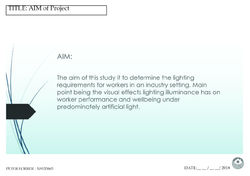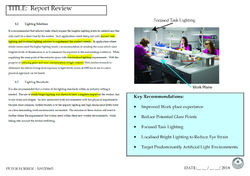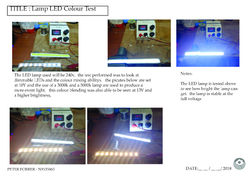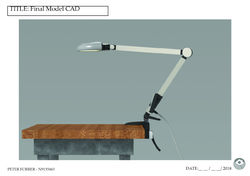Vision
The Vision Work Lamp is an innovative task lamp, designed to improve the work environment for people who used ultra-bright task lighting. The Vision Work Lamp has two main functions: Automatic mode, providing the user with optimal levels of illuminance and colour maintaining a healthy light source on the work area, reducing eye fatigue and glare. With optional manual mode for user-defined settings, allowing a preferred illuminance and colour to be set. The Vision Work Lamp is designed to improve worker wellbeing increasing workplace satisfaction, additionally increasing worker performance as a result.

Lighting Effects in an Industry Setting
Research Report, Design Proposal & Design Justification
Poor lighting in an industry setting can impede worker well being and performance. This results in workers performing to a lower level, while their dissatisfaction of the workplace environment due to glare or poor lighting conditions can lead to tampering and underutilised work areas. As workers perform tasks throughout their shift, it is the lighting design and the level of illuminance on the work area which determines the speed and time which a task can be performed. As an example, if a worker is performing a visual task and the lighting solution is too bright it will cause glare off the work surface and hinder the worker in their duties, while also causing headaches impeding the wellbeing of the worker.
This study looks at the influences lighting and lighting effects have in an industry setting. Through testing and observation of ten people during a controlled lighting test, it was found that participants preferred light levels of 500 LUX when performing work tasks. These results as so indicated that workers have similar lighting preferences and react to both negatively to lower 50 LUX and brighter 1000 LUX levels of illuminance. These results demonstrate that lighting does have an influence on workers, affecting both the performance and wellbeing. The results discussed in this research paper have identified design implication for the industrial lighting system, with applications in both lighting re-design and new industry settings.
Design Thesis
Design Poster
Project Digital Record
 |  |  |
|---|---|---|
 |  |  |
 |  |  |
 |  |  |
 |  |  |
 |  |  |
 |  |  |
 |  |  |
 |  |  |
 |  |  |
 |  |  |
 |  |  |
 |  |  |
 |  |  |
 |  |  |
 |  |  |
 |  |  |
 |  |  |
 |  |  |
 |  |  |
 |  |  |
 |  |  |
 |  |  |
 |  |  |
 |  |  |
 |  |  |
 |
